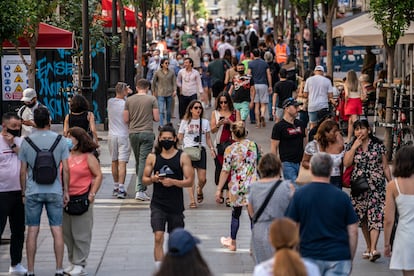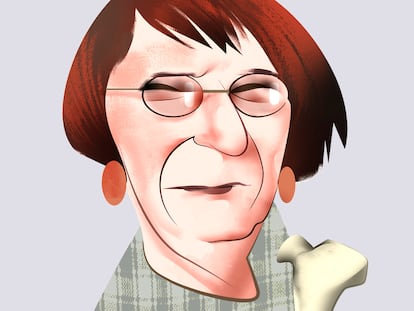A study of cells from four organ donors sheds light on how genetic material is read
An international consortium created personalized maps of the epigenome, the “librarian” that chooses what is read in the cells’ instruction manual

All people were once a single, all-powerful 0.1-millimeter cell, the result of the union between their mother’s egg and their father’s sperm. Inside that single solitary cell, there was already a unique and astonishing text: the genome, more than 3 billion chemical letters with the instructions to multiply and become a human being made up of 30 trillion cells. That is what the American geneticist Francis Collins, a fervent Christian and the former director of the Human Genome Project, calls “the language of God.” But there is another, even higher god. Virtually all of a person’s cells share the same original operating manual, but some read specific pages and become neurons in the brain, while others read other passages and give rise to cells in the muscles, the heart and other organs. This Thursday, an international consortium released the most complete map of the human epigenome, which researchers liken to the book of life.
Scientists have examined the genetic material of four deceased organ donors, two women and two men. According to Roderic Guigó, a researcher at the Center for Genomic Regulation (CRG) in Barcelona, Spain, and a co-author of the study, “This is the most complete individual map of the human epigenome.” The research represents a breakthrough in medicine. The epigenome are chemical compounds that bind to the genome - DNA - as if they were highlighters and bookmarks indicating the parts of a book to be read. The process is fundamental to the normal development of a fertilized egg, but it is also key to the onset of diseases like cancer.
In 2015, another international consortium published a reference map of the epigenome, but Guigó points out that this earlier one was based on the human reference genome, an “archetypal” text that does not correspond to any particular individual; instead, it is a mixture of DNA scraps from a dozen people. The new study, published in the journal Cell, shows the personalized maps of 30 different tissues - lung, heart, liver - from four deceased individuals. “For the first time, we can investigate epigenomic variation across both tissues and individuals,” Guigó says.
If DNA is a book, the epigenome is the person who reads the book, a sort of librarian who decides which parts are readBiotechnologist Beatrice Borsari
A cell’s DNA is organized in 23 pairs of bundles known as chromosomes. In each pair, one chromosome is inherited from the mother and another from the father. Italian biotechnologist Beatrice Borsari emphasizes that this is the first time that both the genome and the epigenome of the two copies of each chromosome have been studied with this level of detail. “If DNA is a book, the epigenome is the person who reads that book, a sort of librarian who decides which parts are read,” says Borsari, who did her doctoral thesis at CRG and is now a researcher at Yale University, another institution in the consortium.
Compared to the reference genome published two decades ago, a person’s genome contains about 4.5 million mutations. Most are harmless, but some alterations can be harmful or beneficial to one’s health. The new epigenomic maps shed light on the effects of these mutations and reveal whether they were inherited from a person’s mother or father. “We have been able to analyze the mutations in the genome of specific individuals, how they modify their epigenome and, therefore, how they can change the way these instructions are read in various tissues,” Borsari explains. In the world of DNA, typos in the book also transform the librarian reading it.
Thomas Gingeras, a geneticist at Cold Spring Harbor Laboratory and one of the consortium’s directors, believes that this is a definite step toward personalized medicine. “It’s been very clear for a long time that the ideal would be to get everybody’s genome sequence and analyze the effect of variations as a basis for diagnosing and choosing a treatment. Medicine is heading in that direction. And this [research] is an attempt to provide a model for doing so,” Gingeras said in a statement.
These are now the foundations on which to build specific research that will tell us about the risk of cancerGeneticist Manel Esteller
The authors have compiled a catalog of millions of mutations, called EN-TEx, which they have used to train an algorithm to predict the impact of these changes on the risk of disease. Beatrice Borsari cites the example of primary ciliary dyskinesia, a rare respiratory disorder, which affects the lungs and ears. “It is a problematic disease and we have been able to study some mutations that occur in a gene and understand how they change the epigenome. If I have a patient with these mutations, I can make predictions,” Borsari explains.
She emphasizes another advantage of her epigenome map: the ability to investigate the effects of mutations on organs that are difficult to access in a living person, such as the heart or the brain. The authors have used machine learning techniques to detect patterns and draw conclusions from a simple blood test.
Geneticist Manel Esteller applauds the new work (he did not participate in the research). “These are the foundations on which to build specific research that will tell us about cancer risk, susceptibility to serious infection and factors related to healthy aging,” says Esteller, the director of the Josep Carreras Leukemia Research Institute in Badalona (Barcelona, Spain).
The authors acknowledge the study’s limitations: they have only investigated the epigenomes of four people, all of whom had European ancestry and lived in the United States. “We would like to add more individuals, for greater statistical power, as well as incorporate people of different ethnicities. A mutation may be common in white individuals, but infrequent in other groups,” Borsari says.
Borsari is already working on medicine’s next phase in her laboratory at Yale University. She explains that “knowing the mutations in the genome is very important, but knowing how they change the epigenome is on another level and it takes us much further. If DNA is my book and the epigenome is the person reading the book, the next step is to find out what happens after you’ve read the book. How does the cell change?”
Sign up for our weekly newsletter to get more English-language news coverage from EL PAÍS USA Edition
Tu suscripción se está usando en otro dispositivo
¿Quieres añadir otro usuario a tu suscripción?
Si continúas leyendo en este dispositivo, no se podrá leer en el otro.
FlechaTu suscripción se está usando en otro dispositivo y solo puedes acceder a EL PAÍS desde un dispositivo a la vez.
Si quieres compartir tu cuenta, cambia tu suscripción a la modalidad Premium, así podrás añadir otro usuario. Cada uno accederá con su propia cuenta de email, lo que os permitirá personalizar vuestra experiencia en EL PAÍS.
¿Tienes una suscripción de empresa? Accede aquí para contratar más cuentas.
En el caso de no saber quién está usando tu cuenta, te recomendamos cambiar tu contraseña aquí.
Si decides continuar compartiendo tu cuenta, este mensaje se mostrará en tu dispositivo y en el de la otra persona que está usando tu cuenta de forma indefinida, afectando a tu experiencia de lectura. Puedes consultar aquí los términos y condiciones de la suscripción digital.
More information
Últimas noticias
Welcome to the post-religion era: The idea of Christianity as the absolute truth has become obsolete
‘I thought you would like it’: The risky sexual practice popularized by TV shows and TikTok
The digitalization of tourism: ‘They promise experiences and gave us the worst possible one’
Mexican peso defies uncertainty with forecasts of a new period of stability in 2026
Most viewed
- Sinaloa Cartel war is taking its toll on Los Chapitos
- Reinhard Genzel, Nobel laureate in physics: ‘One-minute videos will never give you the truth’
- Oona Chaplin: ‘I told James Cameron that I was living in a treehouse and starting a permaculture project with a friend’
- Why the price of coffee has skyrocketed: from Brazilian plantations to specialty coffee houses
- Silver prices are going crazy: This is what’s fueling the rally











































